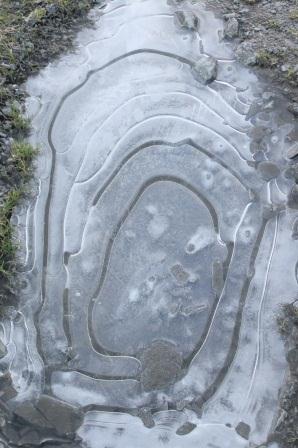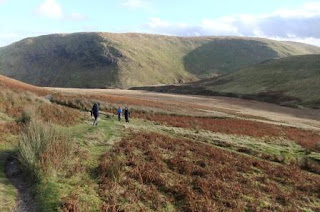Whitefriars Wanderings
Walking, camping & exploring the great outdoors!
Friday 14 December 2012
Friday 30 November 2012
Freezing
Freezing
Ice sculptures are often commissioned at great expense to give an event a 'wow' factor. For most of us though, the good old ice cube tray and, weather permitting, snowman building is probably the extent of our dabbling with ice. I seem to recollect that one of our cookery books, of a certain vintage, detailed how to make an ice bowl from which to serve that 1980s classic... the prawn cocktail. (I never tried it.) So it was fantastic to come across some wonderful natural 'sculptures' when we were out walking on a sunny, blue-skied day right at the end of November.There had been a hard frost and we came across this puddle at the verge of a farm track. The top layer was quite white and still, but underneath the surface there were spiral channels of trickling water around the stones on the track's surface.
 |
| Puddle |
 |
| Crystal clear |
Further up, the snow and ice had remained intact and made for a very impressive sight. Here, the snow had also drifted into ridges emanating from the fence. The contrast of shadow and glistening snow was spectacular. In the sun, the snow sparkled as if it had had a sprinkling of glitter on it. Magical.
The triangulation pillar had also taken on a new guise with sculpted sides.
 |
| Triangulation Pillar - Skiddaw |
 |
| Skiddaw Little Man - summit |
Tuesday 27 November 2012
Silver How, Blea Rigg & Tarn Crag
Silver How, Blea Rigg & Tarn Crag
The lure of three Wainwrights was more than enough to get us out on this rambler's walk starting from Grasmere. A real bonus was to park for free half a mile outside of Grasmere. The ridge we were to walk was clear as we set off in cloudy, but dry weather, though behind us, the tops of Fairfield and Seat Sandal were shrouded in cloud. The forecast was reasonable with improving conditions to look forward to.We skirted Grasmere and went across the Easedale Road before heading up footpaths to the cairn at the top of Silver How. At 395 metres, this was not a high Wainwright, but the views over Grasmere to Rydal Water were stunning.
 |
| Grasmere & Rydal Water from Silver How |
The next target was Blea Rigg at 541 metres, about two miles away. We crossed Brigstone Moss, climbed Long How and Swinescar Pike, from where there were excellent views of Langdale with Crinkle Crags and Bowfell in the background. The recent rain had made it a very green valley. Passing a tarn, it was not long before we reached Blea Rigg, overlooking Easedale Tarn to the north and Elterwater to the south east. This was to be the lunchspot, another superb vista to photograph and post on Facebook as...'Today's lunchtime view.' The large rocks on the rigg made excellent seats, but we were soon off again to our third high point.
 |
| Langdale PIkes from Blea Rigg |
 |
| Easedale Tarn |
At 550 metres, this was the highest point of the day. We picked out the Calf Crag, Gibson Knott, Helm Crag ridge we had walked on the Coast to Coast walk in 2010. The views down to Grasmere over Easedale Tarn were also very impressive.
 |
| Looking back to Tarn Crag |
AND... three Wainwrights bagged!
Tuesday 20 November 2012
Bowscale Fell
Bowscale Fell
Distance: 6 Miles
Highest Point: 702m
The forecast, always a consideration for any walking destination, seemed to suggest that it would be dry. We parked up in the 'Township' of Bowscale and set off up a good bridleway on access land. It was a gradual up. Although a little cloudy, visibility was good and patches of sunlight illuminated farmhouses in the valley and the steep-sided Carrock Fell.Soon the route steepened, as the bridleway climbed the fellside. We crossed over Drycomb Beck without difficulty and continued upwards. A wall of crags appeared in front of us and we scanned the scene to pick out where our footpath would take us. As with all fine views, the glacial Bowscale Tarn lay hidden in a bowl until we were almost upon it. We had been brought to the 'teardrop' top where Tarn Sike was emptying the tarn. Not another soul was about. The breeze was gently rippling the tarn's surface. A large boulder sat begging to be sat upon, and we duly obliged it. A great spot for a photo and to break open the flask for a warming slurp of coffee. It was a little nippy.
 |
| FP from Bowscale Tarn |
 | |
| Bowscale Tarn |
 |
| Bowscale Fell summit wind shelter |
 | ||
| Towards Bannerdale Crags with Blencathra rising up in the distance |
 |
| Bannerdale & Souther Fell |
 | |
| The Tongue |
 |
| Sign at Mungrisdale |
Here we were in mid November, and we had had a wonderful walk. Our companions for the day, AJ & SE, had really enjoyed the change of scenery and 'fresh' air.
Fellbarrow & Low Fell Circular
Fellbarrow & Low Fell Circular
Although the forecast was not too promising with wind and squally showers predicted, we made our way to park at Maggie's Bridge (free!) close to Loweswater. This ramblers walk, undertaken in August, was our first with a new group of people. The route was to take us around the south side of Loweswater and then up to Fellbarrow and Low Fell north of the lake... two Wainwright's to collect.
| Loweswater |
| Footpath around Loweswater |
Our next target, Low Fell, was some mile and a half south. Following the ridge wall up and over both Smithy Fell and Sourfoot Fell, we soon came to the cairn at 423m... the highest point. The wind was pretty strong, so we dropped down out of it and had lunch with superb views over Lorton Vale towards Grasmoor. To our right, Crummock Water was now glistening in the sun with Buttermere beyond, and in the distance Haystacks and the Red pike ridge. All too soon it was time to move off.
| Low Fell |
| Crummock Water from Low Fell |
| Loweswater Fells |
It's a privilege to be able to enjoy them.
Subscribe to:
Posts (Atom)



